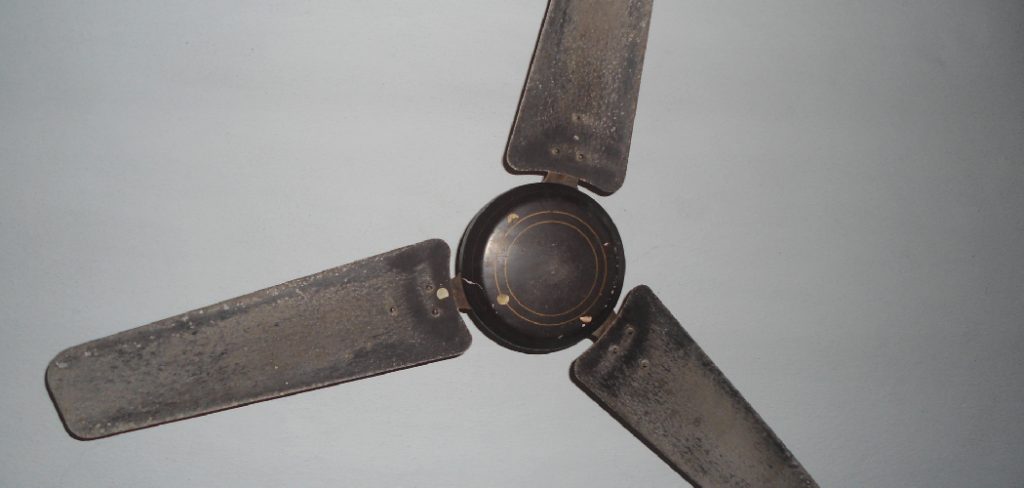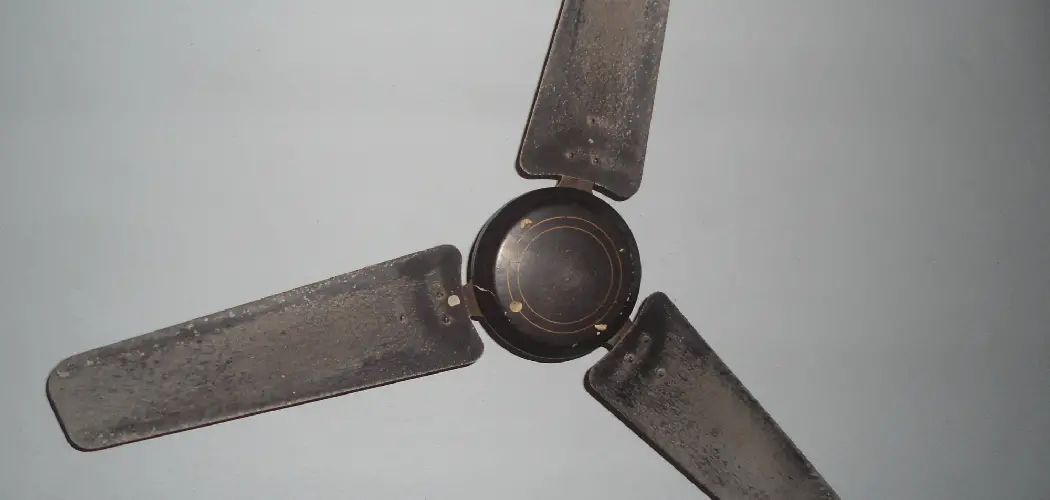Cleaning greasy ceiling fan blades can often be a daunting task, but it is essential for maintaining a clean and healthy home environment. Over time, dust, cooking oil, and other residues can accumulate on the blades, affecting the fan’s performance and contributing to poor indoor air quality.

This guide on how to clean greasy ceiling fan blades will provide you with effective methods and helpful tips to tackle this cleaning chore, ensuring your ceiling fan not only looks great but also operates efficiently. Follow these steps to bring life back to your ceiling fan and enjoy a fresher atmosphere in your living space.
Why is It Important to Clean Greasy Ceiling Fan Blades?
Cleaning greasy ceiling fan blades is crucial for several reasons. Firstly, accumulated grease and dust can hinder the fan’s efficiency, causing it to work harder and use more energy to circulate air. This not only increases energy bills but can also lead to premature wear and tear on the fan’s motor. Secondly, dirty blades can trap allergens and pollutants, which may be released into the air when the fan is in use, potentially exacerbating respiratory issues and allergies for household members.
Lastly, a clean ceiling fan contributes to the overall aesthetic of your home, enhancing its appearance and creating a more inviting office space. Regular maintenance of your ceiling fan blades ultimately promotes better airflow, healthier indoor air quality, and a visually pleasing environment.
Materials Needed
Ladder:
Since ceiling fan blades are usually situated high up, you will need a stable ladder to reach them safely. Ensure the ladder is in good condition and place it on a level surface before climbing.
Cleaning Solution:
Depending on your preference, you can use an all-purpose cleaner or make your own natural solution using equal parts of vinegar and water. Both options work well in cutting through grease and grime.
Microfiber Cloths or Sponges:
These are ideal for wiping away dirt and residue from the ceiling fan blades without leaving any lint behind.
Protective Gear:
It is essential to protect yourself while cleaning greasy ceiling fan blades. Wear gloves and safety glasses to shield your hands and eyes from any cleaning solutions or debris that may fall during the cleaning process.

8 Step-by-step Guidelines on How to Clean Greasy Ceiling Fan Blades
Step 1: Turn Off Power
Before you begin cleaning, it’s crucial to ensure safety by turning off the power to the ceiling fan. Locate the switch on the wall or, preferably, turn off the circuit breaker that supplies power to the fan. This will prevent any accidents during the cleaning process and give you peace of mind as you tackle the grime on the blades.
Always double-check that the fan is not operating by pulling the chain or pressing the remote control—ensuring that it remains completely off while you work.
Step 2: Cover the Area Below the Ceiling Fan
Before you start cleaning, it’s important to protect the area beneath the ceiling fan. Lay down a drop cloth or old towels to catch any dust, grease, or cleaning solution that may fall during the process. This will make cleanup easier afterward and help prevent stains on your flooring.
If you have furniture directly beneath the fan, consider moving it out of the way to avoid any accidental damage. Taking this precautionary step will ensure that your cleaning job is as hassle-free as possible, allowing you to focus on getting the blades spotless.
Step 3: Remove Dust and Debris
Once you have prepared the area safely, it is time to tackle the visible dust and debris on the ceiling fan blades. Using a microfiber cloth or a duster, gently wipe each blade to remove any loose particles. Start from one end of the blade and work your way to the other, being careful not to push dust further onto the blades or downwards.
If your ceiling fan has been neglected for a while, you may want to use a slightly dampened cloth to help capture more dust. This initial step is essential as it prevents dirt from turning into a greasy residue when mixed with your cleaning solution, ensuring a more effective cleaning process overall.

Step 4: Apply Cleaning Solution
Now that you’ve removed the initial layer of dust and debris, it’s time to tackle the greasy residue on the ceiling fan blades. Using your chosen cleaning solution, spray a generous amount onto a microfiber cloth or sponge and wipe each blade. Be careful not to oversaturate the blades as this can lead to damage over time. For tougher stains, allow the solution to sit for a few minutes before wiping clean.
If you prefer using natural cleaners, you can also mix equal parts of vinegar and water in a spray bottle and apply it to the blades in the same manner.
Step 5: Wipe Clean
Using a clean microfiber cloth or sponge, wipe the blades thoroughly to remove any remaining grease and grime. It’s important to use a fresh cloth or sponge for this step as reusing a dirty one will only spread the residue back onto the blades.
For stubborn spots, you can use an old toothbrush or cotton swab dipped in your cleaning solution to spot clean. Once all blades are wiped clean, let them air dry.
Step 6: Repeat if Necessary
After wiping down the blades, take a moment to inspect them for any remaining streaks, grease, or dirt. If you notice any areas that are still dirty, don’t hesitate to repeat the cleaning process. Simply apply more cleaning solution to your microfiber cloth or sponge and carefully wipe the affected blades once again.
For heavy buildup, it may be beneficial to let the cleaning solution sit for a minute before wiping, as this can help to loosen the grime. Ensuring each blade is thoroughly clean not only enhances the appearance of your ceiling fan but also optimizes its performance, contributing to a fresher indoor environment.
Step 7: Clean the Fan Housing and Motor
Once the blades are spotless, the next step is to address the fan housing and motor. Start by using a microfiber cloth or a soft brush to gently wipe down the outer casing of the fan. Avoid using excessive pressure to prevent scratching any surfaces. If you notice any grease buildup or dust around the motor area, carefully apply a small amount of your cleaning solution to a cloth and wipe it clean.

Be cautious not to let any cleaning solution seep into the motor itself, as this can cause damage. For hard-to-reach areas, consider using a vacuum with a brush attachment to remove dust and debris without risking contact with the motor components. A clean motor and housing not only contribute to the overall aesthetics but also help the fan operate efficiently and quietly.
Step 8: Reconnect Power and Enjoy a Clean Ceiling Fan
Once you have completed cleaning the blades, housing, and motor of your ceiling fan, it’s time to reconnect the power and switch it on. Observe the fan for any unusual noises or vibrations that may indicate an issue with the motor. If everything appears to be in working order, you can now enjoy a cleaner and more efficient ceiling fan.
Remember to clean your ceiling fan regularly to maintain its performance and prolong its lifespan. With these simple steps on how to clean greasy ceiling fan blades, you can easily eliminate grease buildup on your ceiling fan blades in no time, ensuring a healthier and more comfortable living space for you and your loved ones!
Frequently Asked Questions
Q: How Often Should I Clean My Ceiling Fan Blades?
A: It is recommended that you clean your ceiling fan at least once a month to prevent excessive dust and grease buildup. However, the frequency may vary depending on factors such as the fan’s location and usage.
Q: Is It Safe to Use Water to Clean My Ceiling Fan?
A: While water is safe to use, it’s important to avoid getting any electrical components wet. When using a damp cloth, make sure it is not overly saturated and always wring out excess water before wiping down the fan blades. For added safety, disconnect the power before cleaning.
Q: Can I Use Harsh Chemicals to Clean My Ceiling Fan Blades?
A: It is not recommended to use harsh chemicals or abrasive cleaners on your ceiling fan blades as they can cause damage over time. Stick to gentle and natural cleaning solutions for the best results. It’s also important to test out any new cleaning solutions on a small, inconspicuous area before using it on the entire fan.

Conclusion
Cleaning your ceiling fan blades is a simple yet essential task that contributes to a healthier living environment and improved air quality. By following the outlined steps on how to clean greasy ceiling fan blades, you can effectively remove grease and dust buildup, ensuring that your ceiling fan operates efficiently.
Regular maintenance not only enhances the appearance of your fan but also extends its lifespan, saving you time and money in the long run. Make ceiling fan cleaning a part of your routine home care, and enjoy the benefits of a fresher, cleaner indoor atmosphere for you and your family.

